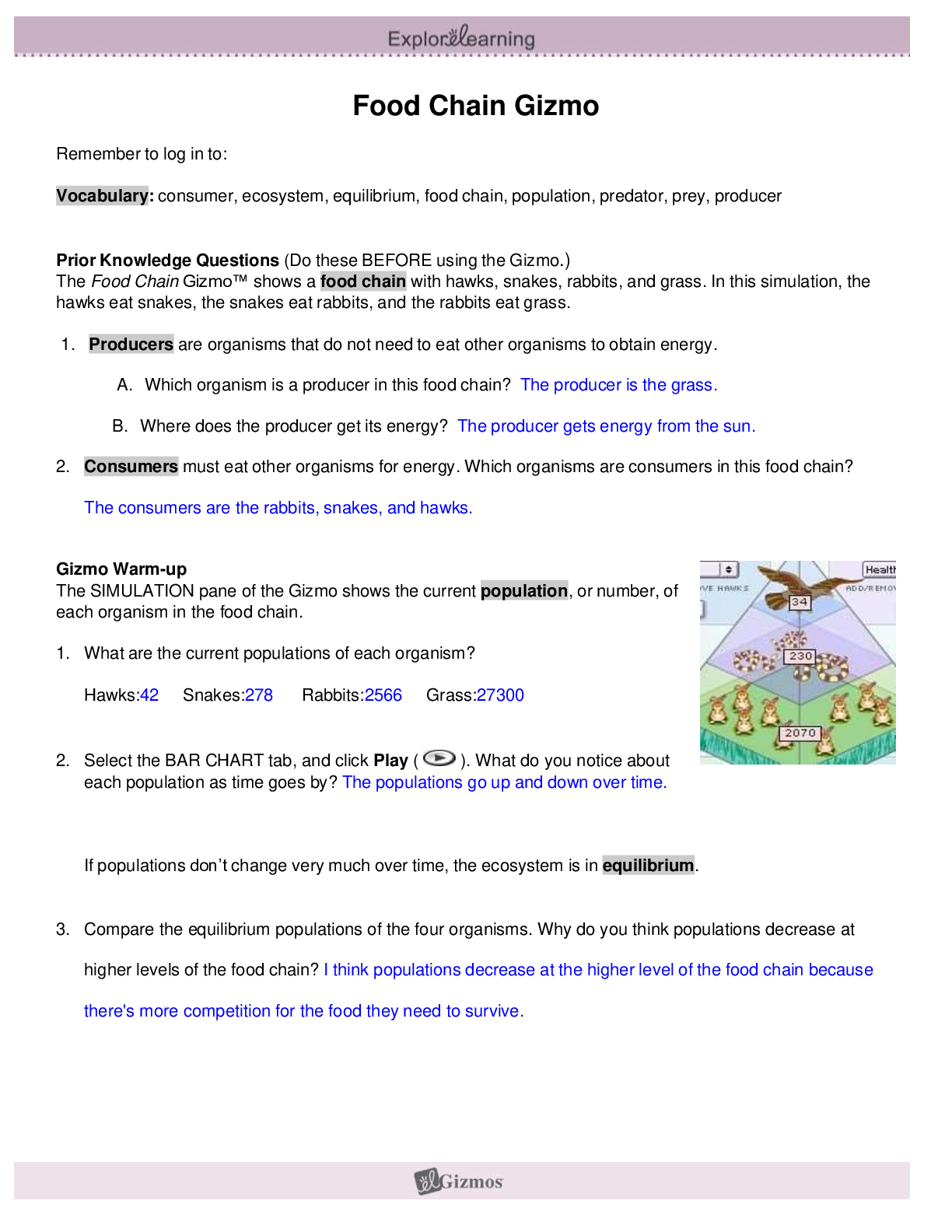
ITS30505 Introduction to Computing |Download for quality grades |
Food Chain Gizmo Remember to log in to: Vocabulary: consumer, ecosystem, equilibrium, food chain, population, predator, prey, producer Prior Knowledge Questions (Do these BEFORE using the Gi ... zmo.) The Food Chain Gizmo™ shows a food chain with hawks, snakes, rabbits, and grass. In this simulation, the hawks eat snakes, the snakes eat rabbits, and the rabbits eat grass. 1. Producers are organisms that do not need to eat other organisms to obtain energy. A. Which organism is a producer in this food chain? B. Where does the producer get its energy? 2. Consumers must eat other organisms for energy. Which organisms are consumers in this food chain? Gizmo Warm-up The SIMULATION pane of the Gizmo shows the current population, or number, of each organism in the food chain. 1. What are the current populations of each organism? Hawks: Snakes: Rabbits: Grass: 2. Select the BAR CHART tab, and click Play ( ). What do you notice about each population as time goes by? The populations go up and down over time. If populations don’t change very much over time, the ecosystem is in equilibrium. 3. Compare the equilibrium populations of the four organisms. Why do you think populations decrease at higher levels of the food chain? Activity A: Predator-prey relationships Get the Gizmo ready: ● Click Reset ( ). ● Check that the BAR CHART tab is selected. Question: Predators are animals that hunt other animals, called prey. How do predator and prey populations affect one another? 1. Observe: Run the Gizmo with several different starting conditions. You can use the + or – buttons to add or remove organisms, or you can choose Diseased from the dropdown lists. 2. Form hypothesis: How do you think predator and prey populations affect one another? I 3. Predict: Based on your hypothesis, predict how changing the rabbit population will affect the other organisms at first. Write “Increase” or “Decrease” next to each “Prediction” in the table. Change Grass Snakes Hawks Doubling rabbit population Prediction:Decrease Result:Decrease Prediction:Increase Result:Increase/Decrea se Prediction:Increase Result:Increase/Decrea se Halving rabbit population Prediction:Increase Result:Increase Prediction:Decrease Result:Decrease Prediction:Decrease Result:Decrease 4. Test: Add rabbits until the population is about twice as large as it was (200% of balance). Click Play, and then Pause ( ) after approximately ONE month. Next to each “Result” line in the table, write “Increase” or “Decrease.” Click Reset and then halve the rabbit population (50% of balance). Record the results for this experiment in the table as well. A. How did doubling the rabbit population affect the grass, snakes, and hawks at first? B. How did halving the rabbit population affect the grass, snakes, and hawks at first? 5. Predict: Predict how changing the snake and hawk populations will affect the other organisms within the first month. In the tables below, write your predictions. Change Grass Rabbits Hawks Doubling snake population Prediction:Increase Result:Increase Prediction:Decrease Result:Decrease Prediction:Increase Result:Increase Halving snake population Prediction:Decrease Result:Decrease Prediction:Increase Result:Increase Prediction:Increase Result:Decrease Change Grass Rabbits Snakes Doubling hawk population Prediction:Decrease Result:Decrease Prediction:Increase Result:Increase Prediction:Decrease Result:Decrease Halving hawk population Prediction:Increase Result:Increase Prediction:Decrease Result:Decrease Prediction:Increase Result:Increase 6. Test: Click Reset. Try each experiment with the Gizmo. Record each result after one month. A. How did increasing the snakes affect the grass? Explain why: B. How did increasing the hawks affect the rabbits? Explain why: 7. Draw conclusions: In general, what effect did removing prey have on predators? What effect did removing predators have on prey? 8. Extend your thinking: In North America, many top predators, such as wolves, have been driven nearly to extinction. What effect do you think this has on their main prey, deer? Activity B: Long-term changes Get the Gizmo ready: ● Click Reset. ● Select the GRAPH tab. Question: An ecosystem is a group of living things and their physical environment. How do ecosystems react to major disturbances? 1. Observe: Kill off most of the hawks using the – button, and then click Play. Observe the GRAPH for about 12 months, and then click Pause. What happens?. 2. Analyze: Explain why you think the population of each organism changed the way it did. I t 3. Experiment: Click Reset. Try making other changes to the ecosystem. Use the + or – buttons, or choose Diseased from the dropdown lists. Click Play and observe for at least 12 months. Record what happens on another sheet of paper or in your notes. 4. Summarize: Give at least one example of each of the following: ...........................................................................................continued............................................................................................................... [Show More]
Last updated: 3 years ago
Preview 1 out of 4 pages

Buy this document to get the full access instantly
Instant Download Access after purchase
Buy NowInstant download
We Accept:

Can't find what you want? Try our AI powered Search
Connected school, study & course
About the document
Uploaded On
Aug 16, 2021
Number of pages
4
Written in
All
This document has been written for:
Uploaded
Aug 16, 2021
Downloads
0
Views
446
Scholarfriends.com Online Platform by Browsegrades Inc. 651N South Broad St, Middletown DE. United States.
We're available through e-mail, Twitter, Facebook, and live chat.
FAQ
Questions? Leave a message!
Copyright © Scholarfriends · High quality services·